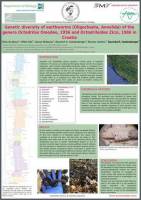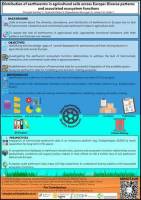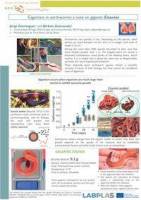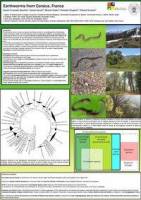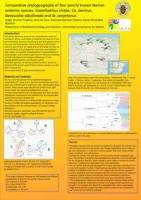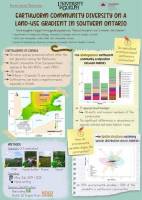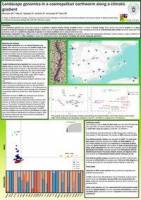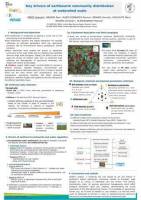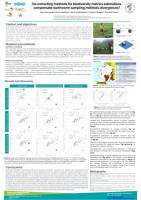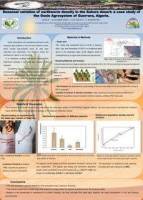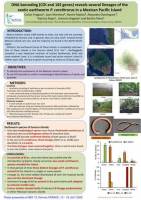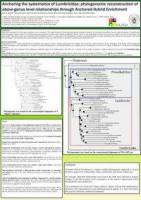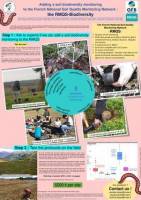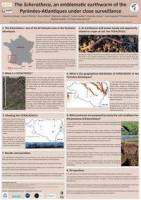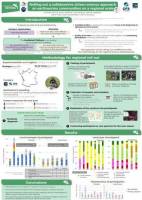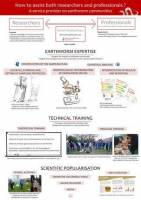Session 5: Earthworm biodiversity and evolution: patterns and mechanisms
(Friday, July 15 – 9:00 a.m. – 3:00 p.m.)
Orals
Rebuilding the systematics of European earthworms (Lumbricoidea, Crassiclitellata) through molecular phylogenetics as a foundation for evolutionary and ecological research
Daniel F. Marchán1, Thibaud Decaëns2, Jorge Domínguez3, Marta Novo4
1 CEFE, UMR 5175, CNRS–Univ Montpellier–Univ Paul–Valéry–EPHE–SupAgro Montpellier–INRA–IRD, 1919 Route de Mende, 34293, Montpellier Cedex 5, France
2 Grupo de Ecoloxía Animal (GEA), Universidade de Vigo, E-36310 Vigo, Spain
3 Depto. de Biodiversidad, Ecología y Evolución, Facultad de Ciencias Biologicas, Universidad Complutense de Madrid, José Antonio Novais, 2, 28040, Madrid, Spain
Earthworm evolutionary biology has been hindered by unstable taxonomy and challenging phylogenetic relationships (due to scarce diagnostic characters and widespread homoplasy). However, molecular phylogenetic techniques have yielded significant improvements in this respect in the last 15 years. Several approaches based on the use of different molecular markers, sequencing techniques and compromises between specimen/taxon coverage and phylogenetic information have recently emerged (DNA barcoding, multigene phylogenetics, mitochondrial genome analysis, transcriptome analysis, targeted enrichment methods and reduced representation techniques), providing solutions to different evolutionary questions regarding European earthworms. The integration of several of these molecular phylogenetic techniques with traditional morphology has led to significant advances in Lumbricidae and Hormogastridae systematics, allowing to delimit and redefine monophyletic genera, and relationships between them. These approaches have also enabled identification of problems that can be resolved by molecular phylogenetics, including revision of conspicuous genera such as Allolobophora and Aporrectodea.
Here, the most impactful changes to the systematics of these two families are presented as a foundation for future research on earthworm ecology aiming to incorporate phylogenetic and evolutionary background. Two facets of earthworm biology which can be improved by molecular phylogenetics are historical biogeography and functional trait evolution: several examples are highlighted in this communication, such as the striking disjunction of relic genera representing ancient widely-distributed lineages or the recurrent appearance of large body size.
Achieving equivalent molecular phylogenetics backbones for systematics of non-European earthworm faunas would allow to extend the scope of such research topics globally, providing evolutionary and ecological models with more explanatory power. Thus, systematic and homogeneized implementation of molecular phylogenetic approaches should be encouraged among the different expert groups worldwide, with emphasis on collaboration and cooperation.
keywords: Molecular phylogenetics; taxonomy; biogeography; functional trait evolution
---------------------------------------------------------------------------------------------------------------------
Is there an ecological niche overlap between native and exotic earthworm species in Martinique?
Quentin Gabriac1,2; Lise Dupont3; Carla-Marie Brunet1,2,3; Mathieu Coulis1,2
1 UPR GECO, Univ Montpellier, F-34398 Montpellier, France
2 CIRAD, UPR GECO, F-97285 Le Lamentin, Martinique, France
3 Institute of Ecology and environmental sciences of Paris, Paris Est Creteil University (UPEC), Sorbonne University, CNRS, INRAE, IRD, 94010 CRETEIL, FRANCE
The Caribbean basin is considered a global hotspot of biodiversity. Since 1886, more than a hundred species of earthworms have been recorded there, many of which are endemic. The volcanic arc of the Lesser Antilles has been relatively less studied than the Greater Antilles. Martinique has never been the subject of a specific study on earthworm diversity. Following preliminary studies, more than thirty species of earthworms have been identified. Exotic species coexist with species that are new to science and probably endemic. These native species may be threatened in various ways, due to global changes or the introduction of exotic species such as other earthworm species that would be more competitive. In this context, it is important to better understand the factors that determine the distribution of the different earthworm species in Martinique in order to identify potential threats to this biodiversity and help its conservation. More specifically, the objective of this work is to test whether there is an overlap between the ecological niches of native and exotic species. The ecological niches of several native and exotic species were therefore modelled using Maxent software. This modelling was carried out using a geo-localised database of earthworm samples taken over the period 2015-2021 and includes variables related to climate, soil type, land use and topography. Initial results suggest that native species are constrained to habitats at higher elevations, where rainfall totals are high and temperatures are relatively lower. For exotic species, soil type and land use seem to be the most important factors. The exotic species Dichogaster andina, Pontoscolex corethrurus show an ecological niche that fully or partially overlaps the ecological niche of several native species. This result shows that some exotic species could be considered as invasive and represents a threat to the biodiversity of earthworms in Martinique.
keywords: Lesser Antilles; Caribbean; Conservation; Soil Biodiversity; Oligochaeta
---------------------------------------------------------------------------------------------------------------------
Earthworm distribution and habitat associations in the British Isles
Ashwood, F. 1, Keith A. M.2, Sherlock, E3, Mason, K.2, and Brown, K. D.4
1 Forest Research, Northern Research Station, Midlothian, UK
2 Centre for Ecology and Hydrology,Bailrigg,Lancaster, UK
3 The Natural History Museum, Cromwell Road, London, UK
4 Earthworm Society of Britain, Cromwell Road, London, UK
Despite their ecological importance for many terrestrial ecosystems, earthworms remain a globally under-recorded biological group. Without current and reliable information on earthworm distributions and ecologies, there is risk of false classifications regarding individual species life histories, distributions, and conservation status. In recognition of the national paucity of earthworm data, the UK’s National Earthworm Recording Scheme (NERS) was established in 2014 togather earthworm distribution data for monitoring and facilitating earthworm research. Almost a decade later, the NERS is now by far the most comprehensive database of earthworm distribution records for Britain (over 18,000 individual records to date). By utilising the NERS database, we identified the species-specific habitat and microhabitat associations of earthworms across the British Isles. We also calculated the earthworm diversity of major land use types and investigated the biases & complementarities between public and research-derived earthworm records. Our findings provide updated(micro)habitat association and distribution data for all earthworm species native to Britain and reveal a disparity between the land use types visited by researchers and the public during earthworm recording. By identifying these patterns and knowledge gaps, we can direct how future earthworm sampling may be targeted to improve our understanding of earthworm geographical and ecological associations.
keywords: Earthworm; Britain; Habitat Associations; Distribution; Diversity
---------------------------------------------------------------------------------------------------------------------
European p hylogeography of Eiseniella tetraedra
Irene de Sosa1, Daniel F Marchán2, Christer Erséus3, Emmanuel Lapied4, Misel Jelic5, Aleksandra Jabłońska6, Timea Szederjesi7, Ana Almodóvar1, Marta Novo1, Darío Díaz Cosín1.
1 Biodiversity, Ecology and Evolution Department, Faculty of Biology, Complutense University of Madrid, C/José Antonio Nováis 12, 28040, Madrid, Spain.
2 Centre d'EcologieFonctionnelle et Evolutive UMR 5175 CNRS 1919 Route de Mende, 34293 Montpellier Cedex 5, FRANCE
3 Systematics and Biodiversity, Department of Biological and Environmental Sciences, University of Gothenburg, Box 463, SE-405 30 Göteborg, Sweden
4 Taxonomia International Foundation, 7 rue Beccaria, 72012 Paris, France
5 Department of Natural Sciences, Varaždin City Museum, Strossmayerovošetalište 3, 42000 Varaždin, Croatia
6 Department of Invertebrate Zoology and Hydrobiology, University of Lodz, Banacha 12/16, 90-237, Łódź, Poland
7 Department of Zoology, Hungarian Natural History Museum, 13 Barossstr, 1088, Budapest, Hungary
Although some earthworms can survive in permafrost and tolerate cold conditions, it is generally believed that most earthworms were eradicated from northern latitudes during the Last Glacial Maximum. However, there was almost complete consensus that disjunctions and endemism in the North Atlantic could not be explained without survival in situ during glacial periods. On the contrary, the tabula rasa hypothesis of postglacial immigration supports the notion that species now found in northern European areas must have been recently recolonized from historical refugia. To test which hypothesis explains the phylogeography of the riparian and parthenogenetic earthworm Eiseniellatetraedra, we collected 1,640 specimens from 19 different countries in Europe. We examined three molecular markers (COI, 16S and 28S) and their morphology. Eleven lineages were found, divided into five clades. Clade I was more prevalent in cold biogeographic regions such as the Continental, the Atlantic or even the Arctic, while clade II was prevalent in Mediterranean regions. We examined their potential niches using Species Distribution Models, which were consistent with distribution trends. The presence of restricted clades in the Iberian and Scandinavian Peninsulas and Eastern Europe suggests that these three regions served as refugia during the Last Glacial Maximum. Thus, both hypotheses were necessary to explain the actual distribution of this shore-dwelling earthworm.
keywords: Refugia; semi aquatic; genetic diversity; Europe
---------------------------------------------------------------------------------------------------------------------
How many worms burrow in the stream edge? The overlooked biodiversity of the semi-aquatic Spaganophilus earthworms
Roberto Carrera-Martínez1, Melanie K. Taylor2, Daniel Jones3, Bruce A. Snyder3, Mac A. Callaham, Jr.2 and Sean D. Schoville4
1 Department of Integrative Biology, University of Wisconsin – Madison, Madison, WI, USA
2 Southern Research Station, USDA Forest Service, Athens, GA, USA
3 Department of Biological and Environmental Sciences, Georgia College and State University, Milledgeville, GA, USA
4 Department of Entomology, University of Wisconsin – Madison, Madison, WI, USA
There is general scientific agreement on the critical role that earthworms play in ecosystems, yet earthworm ecology and diversity are still not well unknown. This is especially true for the semi-aquatic earthworms of the family Sparganophilidae. These earthworms inhabit the interface of terrestrial and aquatic ecosystems, occurring exclusively in saturated soils or sediments, along the shores of lakes, rivers and wetlands. This endemic North American family comprises eleven species in one genus, and has been virtually ignored in terms of diversity or ecology. Our objective was to determine the habitat preferences, and diversity of sparganophilid earthworms. Three sites in the Southern Appalachian Piedmont were selected for this study. At each stream (one small, medium and large at each site), a 50 m transect was placed along the stream bank, and samples were randomly taken at 10m intervals. These sites were sampled during the spring, summer and fall of 2017. Ten species of Sparganophilidae were identified based on morphological characters and molecular data (genes COI, 16S and 28S), all of which are new to science. Additional collection of the exotic, Eukerria saltensis, was common.Octolasion tyrtaeum and at least one Amynthas species were also collected, but rarely. At least two species of aquatic oligochaetes were collected as well, one Tubificidae species and Brachyura sowerbyi. The species accumulation curve of sparganophilids did not plateau, suggesting that more species may yet be discovered at these sites. However, only 19% of the specimens were identifiable adults, with most collected only at the spring sampling and none during the fall. This suggests a strong seasonal phenology, where reproduction occurs during late winter and/or early spring. Each site had a unique sparganophilid community with onlytwo species shared between two sites, suggesting high levels of endemism. We found no difference in abundance between different stream sizes. With this study, the number of sparganophilid species is almost doubled, demonstrating high diversity within a tiny fraction of the distribution of the Sparganophilidae, and emphasizes a critical and evident need for further biodiversity studies focusing on earthworms.
keywords: Endemism; taxonomy; species delimitation; undescribed species
---------------------------------------------------------------------------------------------------------------------
Population genetic structure and diversity of Metaphire remanens (Oligochaeta: Megascolecidae) based on mitochondrial DNA analysis
Qing Jin1,2, Jibao Jiang 1,2*, Jiali Li 1,2 and Jiangping Qiu1,2
1 School of Agriculture and Biology, Shanghai Jiao Tong University, Shanghai 200240, China
2 Key Laboratory of Urban Agriculture (South), Ministry of Agriculture, Shanghai 200240, China
Metaphire remanens is widely distributed throughout Hunan Province, China. We sequenced the mitochondrial DNA to investigate its population genetic structure and genetic diversity, including cytochrome c oxidase subunit I, cytochrome c oxidase subunit II, 12S ribosomal (r)RNA, 16S rRNA, and nicotinamide adenine dinucleotide dehydrogenase subunit 1 derived from 39 individuals in seven geographic locations of the Hunan Province. The genetic diversity indices showed that populations of M. remanens have a strong genetic structure and obvious dispersal histories. Metaphire remanens did not experience population expansion, except in the Xiangtan City. This may be because of its evolution toward parthenogenesis. Divergence time estimates indicated that M. remanens originated between the Hunan Province and Shanghai City at 26.120 Ma and then generated into two main lineages at 2.550 Ma (Quaternary glaciation). These results indicate that glaciation, geographic isolation, and dispersal ability are significant factors influencing the differentiation and dispersal of M. Remanens
keywords: Metaphire remanens; mitochondrial gene; genetic structure; genetic diversity
---------------------------------------------------------------------------------------------------------------------
Endless forms below the surface: Extreme genetic diversity in South American earthworms
David W.G. Stanton1,2, TPI Network2, Ana C. Conrado3, Marie L.C. Bartz2,5, Samuel W. James6, Thibaud Decaëns7, Peter Kille8, George G. Brown9 and Luís Cunha4,10
1 Queen Mary University of London, Mile End Road, Bethnal Green, London E1 4DQ.
2 Terra Preta de Indio network - For a complete list of authors included in this network, please refer to the list of members at http://tpinet.org/people-full/.
3 Departamento de Bioquímica, Universidade Federal do Paraná, Curitiba, Paraná, Brazil.
4 University of Coimbra, Centre for Functional Ecology, Department of Life Sciences, 3000-456 Coimbra, Portugal.
5 Organic Farming - Agriculture and Organic Production Partnership, Idanha-a-Nova, Portugal.
6 Maharishi International University, Fairfield, Iowa, USA.
7 Centre d’Ecologie Fonctionelle et Evolutive CEFE, Université Montpellier, CNRS, EPHE, IRD, 34293 Montpellier, France.
8 School of Biosciences, Cardiff University, Cardiff, CF10 3AX, UK.
9 Embrapa Florestas, Estrada da Ribeira km. 111, Colombo, PR, 83411-000, Brazil.
10 School of Applied Sciences, University of South Wales, Pontypridd Campus, CF37 4AT UK.
Earthworms are a diverse group of animals, occupying most of the regions around the world with a significant ecological role for a variety of ecosystems. Despite their importance, the existing biodiversity gap is still considerable, which is exacerbated in South America. Under a continuous threat of deforestation and biodiversity loss, mapping earthworm diversity and studying their ecology and evolution courses are crucial for their conservation. In this study we have generated genome-wide data for 95 earthworms covering the full range of families autochthonous to South America, including several endemic species, some new to science. Using a two-tier approach, we first evaluated the full range of genetic diversity using barcoding techniques. 47 species units were delimited, and representatives used for a second stage sequencing. We have generated a full mitochondrial genome for each representative and recovered both 18S and 28S ribosomal genes. Phylogenetic relationships were assessed and several new clades, including species unknown to science were phylogenetically positioned. A consistent, strongly supported topology was found irrespective of phylogenetic approach, however, South American earthworms show a deep discordance between mitochondrial and nuclear markers, with profound implications for earthworm taxonomy and evolution.
keywords: South America; Earthworms; Phylogeny; Mitochondrial genome
---------------------------------------------------------------------------------------------------------------------
Earthworm species of Mozambique, Africa
Marie Luise Carolina Bartz1,2; María de JesúsIglesisas Briones3; Sérgio Timóteo1; Henrique Azevedo Pereira1; Sara Mendes1; Artur Serrano4; Mário Rui Canelas Boieiro4; António Alves da Silva1; Joana Alves1; José Paulo Filipe Afonso de Sousa1; Pedro Guilherme Pereira Martins da Silva1
1 Centre for Functional Ecology, Department of Life Sciences, University of Coimbra, Coimbra, Portugal
2 Organic Farming - Agriculture and Organic Production Partnership, Idanha-a-Nova, Portugal
3 Department of Ecology and Animal Biology, Faculty of Biology, University of Vigo, Vigo, Spain
4 Center for Ecology, Evolution and Environmental Change,Faculty of Sciences, University of Lisbon, Lisbon, Portugal
Earthworms play an important role in the support of key soil processes and ecosystem services. Yet, very little is known of the biodiversity of this functional group in several countries of the Afro-tropical region. The first records and description of six native new species of earthworms in Mozambique were published by Michaelsen in 1890. Until the present study only eight earthworm species were recorded for Mozambique: three Acanthodrilidae (D. affinis, D. modiglianii, D. saliens, D. stuhlmanni), three Eudrilidae (Callidrilusscrobifer, Eudriloidesparvus, Nemertodrilus griseus) and one Ocnerodrilidae (Pygmaeodrilusquilimanensis). However, for two out of the eight species above (D. modiglianii andD. saliens) we were still not able to reach the original papers with the original occurance report to confirm them. This study aims to update the list of species for Mozambique and comprise part of the results achieved with the project EcoAssess – A biodiversity and ECOlogicalASSESSment of soil fauna of Gorongosa National Park (Mozambique). This was the first survey of earthworm species from the Gorongosa National Park in Mozambique. Samplings were performed in October and November 2019 and we found a total of 15 earthworm species belonging to the families Acanthodrilidae, Eudrilidae and Ocnerodrilidae. Only two species of the Acanthodrilidae family (D. affinis and D. saliens) were already recorded in the country. D. gracilis is a new record and the remaining 12 species are potential new species or new genus for the country, where seven belong to the three cited families and the other five need more careful taxonomic and molecular analysis to determine their classification. So, Mozambique has now the record of 21 species, where the new species are in process of validation and description.
keywords: East Africa; Afro-tropical region; biodiversity; species occurrence; new species
---------------------------------------------------------------------------------------------------------------------
Hundreds of earthworm species in French Guiana revealed by DNA barcoding of a comprehensive sample set
Arnaud Goulpeau1, Marie-Eugénie Maggia2, Karl Cottenie2, Lise Dupont3, Virginie Roy3, Emmanuel Lapied4, Jérôme Murienne5, Jérôme Orivel6, Heidy Schimann6, Dirk Steinke2, Mickaël Hedde7, Thibaud Decaëns1
1 CEFE, Univ Montpellier, CNRS, EPHE, IRD, Montpellier, France
2 Department of Integrative Biology, University of Guelph, Guelph, Canada
3 iEES-Paris, Univ Paris Est Créteil, Sorbonne Univ, CNRS, INRAE, IRD, Créteil, France
4 Taxonomia International Foundation, Paris, France
5 EDB, Univ Toulouse 3 Paul Sabatier, CNRS, IRD, Toulouse, France
6 ECOFOG, Campus agronomique, Kourou, France
7 Eco&Sols, INRAE, IRD, CIRAD, SupAgro Montpellier, Montpellier, France
Earthworms are recognised for their major ecological role in soil functioning, but the levels and distribution of their species diversity remain little studied, particularly in tropical ecosystems. In this work, we aimed at assessing earthworm species diversity on a regional scale in French Guiana. In 11 sites spread throughout French Guiana, we used a standardised design to sample earthworms in replicated one-ha plots representative of the main habitats available. In order to overcome the taxonomic deficit that characterises tropical earthworms, collected specimens were analysed using DNA barcoding of the COI gene. The resulting sequences were then clustered into operational taxonomic units (OTUs) which were then used as species proxies to describe species diversity patterns from local to regional scales (alpha, beta and gamma diversities).
We produced 4473 sequences that clustered into 326 OTUs over French Guiana, representing a considerable reassessment of regional richness compared to previous studies. We found that local species diversity averaged 38 OTUs per locality and 5 OTUs per community. A small number of OTUs (c.a. 2% of the total) showed a wide distribution (i.e. were found in more than 5 locations), however the majority (c.a. 90% of the total) were only found at one locality, indicating considerable geographical turnover in the composition species pools, which was further confirmed by beta-diversity indices. The rarefaction/extrapolation curves fitted on our data suggest that sampling completion was acceptable at the scale of each individual locality, but that we were still far from the inflection point at the scale of French Guiana as a whole. The Chao index allows us to estimate that at least 400 species could potentially be present in the region. These results confirm the fact that French Guiana represents a remarkable diversity hotspot, and call into question the global diversity estimates currently accepted for earthworms.
keywords: Neotropical earthworms, alpha diversity, beta diversity, gamma diversity, DNA barcoding
---------------------------------------------------------------------------------------------------------------------
Biodiversity inventory of earthworms of Martinique through the use of DNA barcoding unveiled both native and introduced species
Lise Dupont1, Carla-Marie Brunet1,3,4, Samuel James2, Quentin Gabriac3,4,Mathieu Coulis3,4
1 Institute of Ecology and environmental sciences of Paris, Paris Est Creteil University (UPEC), Sorbonne University, CNRS, INRAE, IRD, 94010 Creteil, France
2 Maharishi International University, Fairfield, IA, 52557, USA
3 CIRAD, UPR GECO, F-97285 Le Lamentin, Martinique, France
4 Univ Montpellier, F-34398 Montpellier, France
The Martinique is at the hearth of the Caribbean hotspot of biodiversity, a region known to host a large number of plant and vertebrate endemic species. The species diversity of invertebrate species, and in particular those of the soils, is less well known. One of the objectives of the REBIOS project is to fill the knowledge gap on earthworm diversity in Martinique. Because of the limited number of morphological characters taxonomically valuable in earthworms, this task remains however a challenge. DNA barcoding has been shown to be an effective tool to overcome the taxonomic impediment in earthworms and to facilitate biodiversity assessment in tropical ecosystems.
From specimens sampled during successive prospecting sessions, we first built a reference library for earthworms from Martinique through different DNA-based species delimitation methods. We then used this curated library to assign unknown specimens collected in different epiphytic micro-habitat and sampled in a fragmented landscape situated between the two protected areas of the Montagne Pelé and the Pitons du Carbet. Our preliminary results suggest the existence of several potentially new to science and endemic species in the preserved habitats while the agricultural matrix is largely occupied by an invasive species.
keywords: Arboricolous earthworms; DNA barcoding; species delimitation
---------------------------------------------------------------------------------------------------------------------
Earthworm Watch: citizen science with matched pairs for modelling the functional diversity of UK earthworms
Victoria J. Burton
Life Sciences Department, Natural History Museum, London, UK
Earthworms are among the most accessible soil invertebrates for citizen science approaches, being ubiquitous, easy to find and important in the provision of soil ecosystem services. Despite this, there is a dearth of information about earthworm distribution and how they are impacted by land management, particularly in urban areas. Citizen science has the potential to provide data from private gardens which are difficult for scientists to access. A well-designed project can also help communicate to the public how science is done.
The Earthworm Watch project ran between April 2017 and August 2018 with the aim to model how earthworm abundance and functional types respond to land-use and management. Over 1,800 people in the UK took part, measuring soil properties, earthworm abundance and functional groups. Concerns over data quality are common with data collected by non-experts, so the protocol required a matched pair of samples that differed in land-use type to control for differing effort and ability among participants. This design also helped to convey to participants the value of fair tests.
I used mixed-effects models to focus on the comparisons between plots sampled by the same participant to model earthworm abundance and diversity. Earthworm abundance was significantly affected by soil moisture and texture, and 20% more earthworms were found in sites with organic fertiliser added than in unfertilised sites. Although habitat had less influence on earthworm numbers than soil properties, the three functional groups responded in different ways.
Recruiting participants and maximising survey completion are common challenges facing citizen science projects, so understanding what factors encourage participation is an important question. I used survival analysis to ask what kind of participants were more likely to complete their survey, and how recruitment route influenced this. There is a body of literature on the motivations of those who take part in citizen science projects, and environmental volunteering more widely. I use these existing frameworks to assess what motivated Earthworm Watch participants to take part and discuss how this can inform future projects.
keywords: Earthworm abundance; functional diversity; participant motivations; land-use
---------------------------------------------------------------------------------------------------------------------
A French collaborative platform on earthworms, from citizen science to the monitoring and assessment of the soil biological state
Sarah Guillocheau1,2, Kevin Hoeffner2, Jennifer Scimia2, Lola Morand2, Nathan Lévêque2, Diane Fiala2, Abdourahmane Diallo2, Muriel Guernion2, Daniel Cylly2,Daniel Cluzeau2
1 Micro-company, MME Guillocheau Sarah, Mauron, France
2 University of Rennes, CNRS, ECOBIO [(Ecosystèmes, biodiversité, évolution)] - UMR 6553, Rennes, France
The biogeography as well as anthropogenic and natural factors driving earthworm communities (composition and structure) remain largely unknown, which raises a strong interest from the scientific community to obtain community data in different contexts (e.g. land use and management, soil properties...). In addition, stakeholders (e.g. farmers, local authorities, urban planners and natural area managers) show a growing interest to obtain simple and reliable indicators to assess soil biological state and soil functioning. Within soil organisms, earthworms are largely identified as relevant bioindicators of soil state. In order to compensate for these missed data and accelerate the transfer of knowledge and tools for stakeholders, the University of Rennes 1 developed progressively since 2011 a collaborative platform on earthworms called EcoBioSoil, which includes several projects such as the citizen science project called OPVT, the biological monitoring of 500 plots each year on the french territory called SBT-ENI as well as the REVA which transforms the assessment of soil biological state into soil management advices. EcoBioSoil has several purposes : i) to offer, through earthworm assessment, a cheap, fast and simple tool for the assessment of the soil biological state in natural and anthropic soils, ii) to provide training courses to stakeholders, iii) to supply a database on earthworms with abundance and diversity data and also with the storage of individuals in pure alcohol and iv) to propose reports (for an individual plot or for a group of plots, by adapting the baseline according to geography, land use and/or management).
To date, more than 7000 plots have been sampled throughout France since the beginning of the EcoBioSoil platform and the sampling rate is constantly increasing, especially in urban and natural habitats. For example, in 2021, 1000 plots have been sampled and 400 individual reports have been returned. This platform is an opportunity to build solid thresholds and baselines in different land use and management at a national scale for stakeholders. Details of this collaborative project will be presented, i.e. sampling protocols, tools for training, results and returns for end-users.
keywords: Assembly rules; biological monitoring; database; training; report
Posters
Mitochondrial DNA evidences reflect population structure in Amynthas aspergillum (Oligochaeta: Megascolecidae) in southern China.
Jiali Li 1, Jibao Jiang 1, Qing Jin 1, Zhu Yuan 2 and Jiangping Qiu 1
1 School of Agriculture and Biology, Shanghai Jiao Tong University, Shanghai, China; 18786636984@sjtu.edu.cn (J.L.);jq20190001@sjtu.edu.cn (Q.J.)
2 School of Pharmacy, Shanghai University of Medicine & Health Sciences, Shanghai, China; zhuyuan0452@sjtu.edu.cn (Z.Y.)
Amynthas aspergillum (Perrier, 1872) is the natural resource of traditional Chinese medicine(Guang-dilong) with a high economic value, are widely distributed in Southern China. To investigate the extent of genetic differentiation and genetic diversity of Amynthas aspergillum, a population genetic structure study was undertaken based on 102 samples from 47 locations in in Southern China using mitochondrial DNA (COI, COII, 12S rRNA, 16S rRNA, and ND2). Results showed high levels of genetic diversity and the genetic variations mainly from within the populations. Two deeply divergent mitochondrial lineages (lineage A and lineage B) were detected both by phylogenetic tree and haplotype network analysis, and this finding was supported by high K2P genetic distance and FSTvalue. There was no obvious geographical distribution of individuals in lineage A, while lineage B is only distributed in Guangxi and Yunnan with more complex geographical environment. It was speculated that lineage B exists as a new cryptic species, but was questioned due to the small number of samples obtained.
keywords: earthworms; megascolecidae; Amynthas aspergillum; population genetic structure; genetic differentiation
---------------------------------------------------------------------------------------------------------------------
Field sampling, integrative taxonomy, biodiscovery and the identification of the earthworm taxonomic deficit
Thibaud Decaëns1, Daniel Fernández Marchán1, Marie Luise Carolina Bartz2,3, Sylvain Gérard4, Arnaud Goulpeau1, Mickaël Hedde4, Emmanuel Lapied5, Marie-Eugénie Maggia6, Eric Marcon7, Helen Phillips8, Samuel W. James9
1 CEFE, Univ Montpellier, CNRS, EPHE, IRD, Montpellier, France
2 Centre for Functional Ecology, Department of Life Sciences, University of Coimbra, Coimbra, Portugal
3 Organic Farming - Agriculture and Organic Production Partnership, Idanha-a-Nova, Portugal
4 Eco&Sols, INRAE, IRD, CIRAD, SupAgro Montpellier, Montpellier, France
5 Taxonomia International Foundation, Paris, France
6 Department of Integrative Biology, University of Guelph, Guelph, Canada
7 AMAP, IRD, CIRAD, CNRS, INRA, Univ Montpellier, Montpellier, France
8 German Centre for Integrative Biodiversity Research (iDiv) Halle-Jena-Leipzig, Leipzig, Germany
9 Sustainable Living Department, Maharishi International University, Fairfield, USA
The question of how many species there are on Earth, despite having long captivated scientists, remains an important and unresolved issue. Yet answering this question is central to describing the distribution of the world's biodiversity and defining conservation priorities. This is particularly true for earthworms, which comprise about 5,000 recognized species, but whose true diversity remains largely unknown. In this study, we address the way sampling strategy and integrative taxonomy can successfully identify the extent of the taxonomic deficit and participate to biodiscovery for both tropical and temperate earthworms. For this, we used a global checklist of recognized species (Drilobase), a global dataset with nearly 200 regional species lists (Phillips et al. 2021 Sci. Data), and two regional datasets from French Guiana (Maggiaet al. 2021 Appl Soil Ecol) and Mediterranean France (Fernández Marchánet al. 2022 Zoosystema). Modelling the temporal dynamics of new taxon descriptions from the global species list resulted in a global estimate of at least 11,000 species. However, analysis of the global dataset by Phillips et al. revealed higher beta diversity, and lower sampling effort and sample coverage in tropical than in temperate regions. The reliability of the global species diversity estimate is therefore likely to decrease from the highest to the lowest latitudes, resulting in an underestimation of the number of species in the tropics. This is confirmed by the comparison of the two regional datasets, in which the combination of systematic sampling and integrative taxonomy (combining morpho-anatomical characters and DNA barcodes) allowed to highlight the extent of the taxonomic deficit, and to identify cases of cryptic diversity and species possibly new to science (including in temperate regions). Overall, our results highlight the need to intensify systematic sampling of earthworms in a way that allows further estimation of beta diversity and species numbers from regional to global scales. Integrative taxonomy is also a discipline that needs to be promoted, especially in the training of young researchers, if we are to have the means to describe earthworm species diversity and understand its global distribution.
keywords: Taxonomic deficit;DNA barcoding; sampling; biodiscovery; diversity estimates
---------------------------------------------------------------------------------------------------------------------
Genetic diversity of earthworms (Oligochaeta, Annelida) of the genera Octodrilus Omodeo, 1956 and Octodriloides Zicsi, 1986 in Croatia
Dino de Bona1, Mišel Jelić2, Goran Klobučar1, Branimir K Hackenberger3, Roman Ozimec4, Davorka K. Hackenberger3
1 Faculty of Science, Department of Biology, Rooseveltov trg 6, HR-10000 Zagreb, Croatia
2 Natural History Department of the Varaždin City Museum, Šetalište Josipa Jurja Strossmayera 1, HR-42000 Varaždin, Croatia
3 J. J. Strossmayer University, Department of Biology, Cara Hadrijana 8A, HR-31000 Osijek, Croatia
4 ADIPASociety for Research and Conservation of Croatian Natural Diversity, Orehovečki ogranak 37, HR-10040 Zagreb, Croatia
Octodrilus and Octodriloides genera represent a diverse group of lumbricid earthworms. The species are widespread throughout Europe, but the Trans-Aegean subdomain, which includes Alpine-Balkan-Carpathian region, is considered as an evolution origin. Croatian territory is one of the centers of divergence of these genera. Octodrilus includes at least 53, and Octodriloides at least 22 described species, with numerous subspecies within both genera. So far, 15 Octodrilus species (seven endemic), and five Octodriloides species (four endemic)have been recorded in Croatia. In databases(e.g. BOLD and GenBank) publicly available sequences of these genera from Croatia are almost non-existent, making this molecular research a first study of its kind in Croatia.180 specimens were isolated from several collections, sampled at 76 sites throughout Croatia. The specimens were identified to species level according to identification keys. Specimens were barcoded by isolating, amplifying and sequencing the COI region of mtDNA from the epithelial tissue of each specimen. The obtained sequences of each specimen were processed and compared, and one phylogenetic tree of both genera was constructed by the method of the highest probability. By tree analysis, according to the degree of support and genetic distance, 28 lines representing potential species and/or subspecies were separated. 25 lines were included in 13 described species. Four species form complexes of at least two lines, and three lines are unique in their dislocation from others and do not lead to the described species using identification keys due to specific morphological features or due to specimen’s juvenile stage. Consensus among published research indicates that two specimens of earthworms can be considered separate species if their genetic distance calculated by Kimura 2-parameter is greater than 15%, and if there are morphological differences between sister lines when the genetic distance value is 9-15%. The largest genetic distance between lines in this study is 25.3%, while the lowest is 11.8%. It should be noted that only one molecular marker (COI) was used in this study and it is not possible to reliably determine the hierarchical relationships of Octodrilus and Octodriloides genera species, as well as the monophyletic origin of each genus.
keywords: COI; Octodrilus; Octodriloides; endemic species
---------------------------------------------------------------------------------------------------------------------
Spatiotemporal Evolution of Megascolecidae Earthworm Species in China
Jibao Jiang, Jing Sun, Qi Zhao, Yan Dong, Zhu Yuan, Jiali Li, Qing Jin, Jiangping Qiu
ShanghaiJiao Tong University
Megascolecidae is the most important and widely distributed earthworm family in China. However, the evolutionary history of Megascolecidae remains unclear. Here, we assumed that the speciation of Megascolecidae earthworms is jointly driven by their dispersal and heterogeneity in the soil environment. To test the speciation hypothesis in the Megascolecidae by analyzing mitochondrial genes and genomic single nucleotide polymorphisms, we constructed a highly supported and dated phylogeny of Megascolecidae, comprising 516 species/subspecies collected from China. These results suggest Megascolecidae of China likely originated from the Indo-China Peninsula and subsequently expanded to several provinces; speciation radiation occurred during the Cenozoic. Speciation of Megascolecidae earthworms was highly associated with dispersal processes and environmental factors (temperature and precipitation).
keywords: Earthworm; Megascolecidae; Evolution; Speciation;Dispersal
---------------------------------------------------------------------------------------------------------------------
Distribution of Earthworms and their functional parameters in agricultural soils across Europe
Sharjeel Ashfaq1, Guénola Pérès2, Lorenzo D'Avino3, Maria Viketoft 4, Rajasekaran Murugan5, Johann G. Zaller1
1 Institute Zoology, University of Natural Resources and Life Sciences, Vienna
2 UMR SAS INRAe Institut Agro Rennes-Angers, 65 rue de Saint Brieuc, 35042 Rennes cedex, France
3 CREA-AA, Research Centre for Agriculture and Environment, Florence, Italy
4 Department of Ecology, Swedish University of Agricultural Sciences, SE-750 07 Uppsala, Sweden
5 Institute of Soil Research, University of Natural Resources and Life Sciences, Vienna
Earthworms are among the most important soil organisms in agricultural soils. They perform services as colonizers and engineers within the soil, and through their interactions with other soil biota, can contribute to soil health, nutrient cycling, changes in soil food web dynamics, organic matter decomposition, and disease control. However, little is known about the diversity, abundance, and distribution of earthworms in Europe. Furthermore, the extent to which soil properties and agricultural management practices impact earthworms is not well understood. Investigating of underlying ecological relationships is hampered by the lack of harmonized, interactive, and continental-scale data in agroecosystems. To assess the role of earthworms in agricultural soils, appropriate functional indicators with their patterns and biomass are needed. The project MINOTAUR (Modelling and mapping soil biodiversity patterns and functions across Europe) under the EJP SOIL program aims to address the lack of harmonized and central databases for earthworms and other soil biota and their driving factors in agricultural soils across Europe. Earthworm diversity and biomass will be identified and collected from various data platforms, databases, EU projects and considers grey data sources in different countries. The database in agricultural systems will be compared (earthworms in arable vs perennial) with associated soil functions and properties. Standardized metadata templates will be developed for collected data in reference to location, management practices and condition of agricultural soils. Data will be harmonized with closely interaction with project partners (e.g., EUdaphobase, European Soil Observatory, JRC databases) to make an interactive inventory of European soil macro invertebrates indicating driving factors (climatic and soil and management variables) for long term-use and to identify knowledge gaps on soil biodiversity research. Sharing data with a reference database will allow researchers to investigate and respond to a wide range of topics, such as simultaneously evaluating soil macrofauna diversity distributions and causes of diversity change. Finally, such a comprehensive database will support policy makers in their efforts to halt a further loss of soil biodiversity across Europe.
keywords: Earthworms; Biodiversity; Soil database; Soil macrofauna
---------------------------------------------------------------------------------------------------------------------
Delineation of operational units from earthworm DNA barcodes: a comparison of methods
Arnaud Goulpeau1, Benoit Penel1, Marie-Eugénie Maggia2, Karl Cottenie2, Emmanuel Lapied3, Jérôme Murienne4, Jérôme Orivel5, Heidy Schimann5, Dirk Steinke2, Mickaël Hedde6, Thibaud Decaëns1
1 CEFE, Univ Montpellier, CNRS, EPHE, IRD, Montpellier, France
2 Department of Integrative Biology, University of Guelph, Guelph, Canada
3 Taxonomia International Foundation, Paris, France
4 EDB, Univ Toulouse 3 Paul Sabatier, CNRS, IRD, Toulouse, France
5 ECOFOG, Campus agronomique, Kourou, France
6 Eco&Sols, INRAE, IRD, CIRAD, SupAgro Montpellier, Montpellier, France
With the advent of next generation sequencing, the quantities of sequences produced in DNA barcoding or DNA metabarcoding approaches are increasingly large, opening new fields for biodiversity research. One possible use of these DNA barcodes is to delimit them into operational taxonomic units (OTUs), that are potentially used as species proxies to estimate community diversity and describe their spatial distribution while circumventing the pitfalls set by the taxonomic deficit. In earthworms, our ability to delineate such OTUs is challenged by high levels in both interspecific divergence thresholds and intraspecific variability on the barcode region of the COI gene. These characteristics imply that most OTU clustering methods tend to over-split species into multiple OTUs. In this work, we tested several OTU clustering approaches on a dataset containing 1675 earthworm COI barcodes from French Guiana, namely Poisson Tree Processes (PTP), General Mixed Yule Coalescence (GMYC), Refined Single Linkage (RESL, used for assigning Barcode Index Numbers – BINs – in the Barcode of Life Data systems), Automatic Barcode Gap Discovery (ABGD) and Assemble Species by Automatic Partitioning (ASAP). We analysed the strengths and weaknesses of each of these methods taking into account the ergonomics of the software, the calculation time required, the level of expertise required to use the method, and the relevance of the result outputs. It was found that the ASAP software is the most relevant for large earthworm DNA barcode datasets. It is remarkably fast compared to other methods, and has the advantage of producing 10 delineations of OTUs that can be used for comparison with other information layers in an integrative approach. In our case, the delineations proposed by ASAP were congruent with the morpho-anatomical information available for a subsample of our total dataset.
keywords: DNA barcoding, OTU delineation, method comparisons, species richness, Neotropics
---------------------------------------------------------------------------------------------------------------------
Spontaneous contractive activity of gizzard muscles of Eisenia fetida (Oligochaeta, Lumbricidae)
Veronika S. Abukenova
Karaganda Buketov University, Karagandа, Kazakhstan
Smooth muscle cells with spontaneous contractile rhythm are known to determine the motor ability of the digestive tract. The impellent function of the digestive tract of earthworms is the most important internal and permanent factor of the digestive process and still insufficiently studied in ecologo-physiological relation. The contractive activity of the visceral (gizzard) smooth muscles of epigeic, corticolous species Eisenia fetida was studied according to the method of isolated preparations. This peregrine species known as the model of ecological researches also. In Kazakhstan compost species E. fetida is connecting with cenoses of human activity and forming stable populations here. The basic spontaneous contractive activity of the muscles were phase. The gizzard muscles of the E. fetida showed amplitude 52,55±2,78 per/mg, and frequencies were 4,05±0,42 contr/min. We compared the new results with the previously obtained for some species of the genus Eisenia. The biggest average amplitude and frequency were registered for the endogeic species. Gizzard muscles of epiendogeic earthworms contracted with less force and faster. We assume that parameters of contractive activity of gizzard muscles are identifying the information about specific phisiological pattern and valid as characteristics for life forms of Lumbricidae. Therefore more studies we need and additional data.
keywords: Eisenia fetida; gizzard; contractive activity.
---------------------------------------------------------------------------------------------------------------------
Characterization of Four Earthworm Species Mitogenomes from Northeast China and Phylogenetic Implication (Oligochaeta: Lumbricidae, Moniligastridae)
Huifeng Zhao1, Shuanghu Fan1, Nonillon M. Aspe2,Lichao Feng3, Yufeng Zhang1,4
1 Hebei Key Laboratory of Animal Diversity, College of Life Science, Langfang Normal University, Langfang 065000, China
2 College of Science and Environment, Mindanao State University at Naawan, Naawan 9023,Misamis Oriental, Philippines
3 Jilin Agricultural Science and Technology University, Jilin, 132101, China
4 Jilin Provincial Key Laboratory of Animal Resource Conservation and Utilization, College of Environment, Northeast Normal University, Changchun 130117, China
Earthworms are important soil ecological group, especially in agricultural regions in Northeast China. However, fewer studies focus on this group of organisms compared with other faunal groups.Here, we sequenced 15 new mitogenomes of Aporrectodea tuberculata, A.trapezoides, Eisenia nordenskioldi and Drawida ghilarovi in Northeast China using high throughout sequencing platform. These incompletecircular and double-stranded mitogenomes vary from 14,998bp to 16,123 bp in size and include 37 genes and a putative control region. Quantities of intra species genetic divergence were detected in lumbricid species, and a 122 bpnon-coding region that belongs to control region in A. tuberculata and acontrol region in D. ghilarovi were reported for the first time comparison to the mitogenomes of the congeners. Phylogenetic analysis based on coding genes and ribosomal DNAs datasets using BI and ML inferences showed the non-monophyly of Aporrectodea and polyphyly of E.nordenskioldi. Future works should examine the taxonomy, phylogeny of Lumbricidae, and population genetics of earthworms in Northeast China or Asia using mitogenomicand nuclear data.
keywords: Earthworms, Phylogeny, Lumbricidae,Mitogenomes, Non-coding region
---------------------------------------------------------------------------------------------------------------------
Gigantism in earthworms: a note on gigantic Eisenias
Jorge Domínguez1 and Afrânio Guimaraěs2
1 Universidade de Vigo, GEA (Grupo de Ecoloxía Animal), 36310 Vigo, Spain
2 Minhobox, Juiz de Fora, Minas Gerais, Brazil
Earthworms are iteroparous animals with indeterminate growth, continuing to increase in size throughout their life and after completion of sexual development. Terrestrial oligochaetes vary greatly in size. Depending on the species, adult earthworms can reach between 10 mm and 3 m in length and between <1 mmand >25 mm in width, with most of length 5-15 cm. Among the more than 7000 species described to date, very few (~20) reach lengths greater than 1 m. The longest worm on record is probably Amynthas mekongianus (found in the mud banks of the Mekong River in Southeast Asia),which reaches 3 m in length andis about the same size as Megascolides australis, the ‘Giant Gippsland Earthworm’. These atypically giant earthworm species remain a scientific curiosity in terms of their biology, but they cannot be considered cases of gigantism. Gigantism occurs when organisms are much larger than normal or exhibit excessive growth.
Earthworms obtain energy from the organic matter on which they feed, and growth mainly depends on the quality of the resource and on the species, as well as on food availability, environmental factors (which can directly or indirectly affect growth by modifying food availability) and other biotic factors such as competition. This is particularly evident in animals, such as earthworms, with indeterminate growth and large, species-dependent variations in size.
Eisenia fetida (Savigny 1826) and Eisenia andrei (Bouché 1972) are the earthworm species most commonly used in vermicomposting and vermiculture, nd their biology, life cycle and growth and reproduction rates have been widely reported.
Here we present details of the enormous growth of individual specimens of Eisenia spp. reared under particular culture conditions and fed a special diet. Individuals that are almost 20 times the average weight of the species have been obtained. Possible mechanisms explaining this interesting phenomenon are discussed.
keywords: Gigantism; earthworm growth; Eisenia.
---------------------------------------------------------------------------------------------------------------------
Earthworms from the Mitaraka Massif, FrenchGuiana
Thibaud Decaëns1, Marie Luise Carolina Bartz2-3, Marie-EugénieMaggia4, Emmanuel Lapied5, Alexander Feijo6, Samuel Wooster James7
1 CEFE, Univ Montpellier, CNRS, EPHE, IRD, Univ Paul Valéry Montpellier 3, Montpellier, France.
2 Centre for Functional Ecology, Department of Life Sciences, University of Coimbra, Coimbra, Portugal
3 Organic Farming - Agriculture and Organic Production Partnership, Idanha-a-Nova, Portugal
4 Department of Integrative Biology, University of Guelph, N1G 2W1 Guelph, Canada
5 Taxonomia International Foundation, 7 rue Beccaria, 72012 Paris, France.
6 Facultad de CienciasAmbientales, UniversidadTecnológica de Pereira, A.A. 097, Pereira, Colombia.
7 Sustainable Living Department, Maharishi International University, Fairfield, IA 52557, USA
Despite their undeniable importance for the functioning of soils and terrestrial ecosystems, earthworms are relatively poorly known from a taxonomic point of view, particularly in little-studied and difficult-to-access tropical regions. Since 2010, several sampling campaigns focusing on biodiversity assessment and including earthworms have been carried out in different parts of French Guiana. In this work, we present the result of the earthworm sampling conducted in March 2015 during the Our Planet Reviewed expedition in the Mitaraka Massif, Southern French Guiana. Sampling was done following a standardised protocol in a selection of replicated plots covering the main habitats available. Collected earthworms were DNA barcoded targeting the COI barcode region, and grouped in operational taxonomic units (OTUs) according to their genetic similarities. A selection of specimens from each OTU was dissected for morpho-anatomical descriptions. Overall, we obtained 347 sequences that clustered in 31 OTUs. At the time of writing this summary, we have finalised the morphological diagnoses on 14 of these OTUs,of which11 have already been identified as species new to science(9 within Martiodrilus, 1 Andiorrhinus, and 1 Urobenus) whose descriptions will be the subject of a forthcoming taxonomic work. The results are used to discuss the ecological structure or the species pool and the Linnaean shortfall that characterises the earthworm fauna of French Guiana.
keywords: Neotropics, integrative taxonomy, new species
---------------------------------------------------------------------------------------------------------------------
Earthworms from Corsica, France
Daniel Fernández Marchán1, Sylvain Gérard2, Mickaël Hedde2, Rodolphe Rougerie3, Thibaud Decaëns1
1 CEFE, Univ Montpellier, CNRS, EPHE, IRD, Montpellier, France
2 Eco&Sols, INRAE, IRD, CIRAD, SupAgro Montpellier, Montpellier, France
3 Muséum national d’Histoire naturelle, Institut de Systématique, Evolution, Biodiversité, UMR 7205 ISYEB, MNHN, CNRS, EPHE, Sorbonne Univ, Univ Antilles, Paris, France
Diversity of earthworm communities in Mediterranean islands is poorly known, but fragmentary studies have shown remarkable diversity and endemicity. Available studies of the earthworm fauna of Corsica reported a total of 36 species, but this regional diversity is probably underestimated considering the relatively modest sampling efforts achieved so far. We conducted a sampling campaign in the context of the program Our Planet Reviewed, with the aim to increase sampling coverage and to analyze already known regional diversity with a combination of classical morpho-anatomic characters and DNA barcoding. We sampled a total of 31 locations, and produced 525 COI barcodes which clustered into 48 genetic lineages, among which 29 corresponded already known species within the families Acanthodrilidae, Hormogastridae and Lumbricidae. Several of these species were composed of already documented complexes of cryptic lineages, and 10 COI-based lineages were supported by multiple lines of evidence and were described as species new to science. Our contribution allowed an upward reassessment of Island regional diversity, which goes from 36 to 41 species, and suggested that at least 20 more species could still be discovered there. Biogeographical affinities of the identified species showed a lower rate of cosmopolitan species compared to other Mediterranean islands, a certain degree of affinity with Italy and Sardinia, and a high rate of endemism (which could be mirrored by the Balearic Islands and Sardinia). Comparative phylogeographic analyses will represent the next step to address the histories of earthworm colonization and diversification in this Mediterranean island, and to investigate the drivers that shaped the distribution of their diversity.
keywords: DNA barcoding, endemism, Mediterranean islands, new records, new species
---------------------------------------------------------------------------------------------------------------------
Revisiting Eiseniella neapolitana and Norealidys andaluciana (Annelida, Lumbricidae)
Irene de Sosa1, Daniel F Marchán2, Marta Novo1, Timea Szederjesi3, Misel Jelic4, Aleksandra Jabłońska5, Raúl Navarro1, Ana Almodóvar1, Darío Díaz Cosín1.
1 Biodiversity, Ecology and Evolution Department, Faculty of Biology, Complutense University of Madrid, C/José Antonio Nováis 12, 28040, Madrid, Spain.
2 Centre d'EcologieFonctionnelle et Evolutive UMR 5175 CNRS 1919 Route de Mende, 34293 Montpellier Cedex 5, France.
3 Department of Zoology, Hungarian Natural History Museum, 13 Barossstr, 1088, Budapest, Hungary.
4 Department of Natural Sciences, Varaždin City Museum, Strossmayerovošetalište 3, 42000 Varaždin, Croatia.
5 Department of Invertebrate Zoology and Hydrobiology, University of Lodz, Banacha 12/16, 90-237, Łódź, Poland.
The semiaquatic earthworm Eiseniella neapolitana was related to the cosmopolitan species Eiseniella tetraedra and even considered a subspecies of it. Norealidys andaluciana was described in Spain and is usually synonymized with E. neapolitana. We collected 69 specimens from Italy, Spain and Cyprus and studied five molecular markers (COI, 16S, 28S, 12S and ND1) and their morphology to solve this taxonomic problem. These studies confirm the genus Norealidys and reject the widely accepted synonymy. Moreover, this study shows that N. andaluciana and E. neapolitana are closely related, which is why we renamed the latter Norealidys neapolitana. The similar morphological appearance despite clear genetic differences among the three species should be explained by convergence to the aquatic habitat. Despite the expected low haplotype diversity based on the 28S gene, we found surprisingly high variability in the N. andaluciana population in Spain. However, the stable predicted secondary structure and the high content of G+C exclude the presence of a pseudogene.
keywords: Eiseniella; genetic diversity; Norealidys; phylogeny; semi-aquatic habitat.
---------------------------------------------------------------------------------------------------------------------
Differentiation and dispersal of earthworms in the Hengduan Mountains
Qi Zhao, Zhu Yuan, Jibao Jiang, Yan Dong, Jiangping Qiu
Shanghai Jiao Tong University
Earthworm has a weak move ability and is sensitive to the temperature and moisture. The “jump dispersal”, caused by climate change and plate movement, is of great importance in earthworm speciation and geographical patterns. Hengduan Mountain Region (HMR) is a biodiversity hotspot according to its complicated topographic feature and paleoclimate change. However, how its geographical events impact on the evolution of earthworms is rarely unknown. Thus, the objective of the study is to understand the differentiation and dispersal of earthworms in HMR and its influence factors based on the phylogeny analysis of 5 combined mtDNA sequences and restriction site-associated DNA sequencing. Our results showed that: 1) up to now, there were totally 203 (sub-)species belonging to 4 families and 12 genera in HMR. The highest earthworm biodiversity appeared at the latitude of 31º-33ºN and the altitude of 1000-3000 m; 2) earthworm species in HMR were divided into 9 groups and 1 single species. Moniligastridae, Lumbricidae and Megascolecidae were divergent in the late Triassic. The dispersal of Megascolecidae began in the late of Eocene. And the pheretimoid earthworms appeared in Miocene; 3) among three main lineages ofAmynthas yuanjiangensis Sun & Qiu, 2021, G3 had the highest genetic divergence. And only one migration gene flow was from G3 to G2. Based on the paleogeography and paleoclimate of HMR, we presumed that there might be two dispersal routes of the ancestor of Megascolecidae: one was from the southern HMR bordering Xishuang banna and Burma to the north and west in the late of Eocene. The other was from the northeast of HMR neighboring Sichuan Basin to the west, south and north in Miocene. There might be 8 diffused events and 6 geographical isolations. Rivers as the geographical barrier were likely to limit gene flow which influenced the population genetic differentiation. The results will not only have the great biogeographical significance in understanding the response of earthworms to the environmental change, but also help us to predict the tendency of the distribution of soil invertebrates under global environmental change in the future.
keywords: Earthworm, Hengduan Mountain, Phylogeny, Population evolution
---------------------------------------------------------------------------------------------------------------------
Comparative phylo geography of three poorly known Iberian endemic species: Castellodrilus chitae, Ca. ibericus and Eiseniona albolineata
Sergio Jiménez Pinadero1, Irene de Sosa Carrasco1, Alejandro Martínez Navarro1, Daniel Fernández Marchán2
1 Depto. de Biodiversidad, Ecología y Evolución, Facultad de Ciencias Biologicas, Universidad Complutense de Madrid, José Antonio Novais, 2, 28040, Madrid, Spain
2 CEFE, Univ Montpellier, CNRS, EPHE, IRD, Montpellier, France
The Iberian Peninsula seems to be a diversification center for earthworm family Lumbricidae as hinted by the presence of several endemisms and early-branching genera that appears only in this area. One of the most widespread “primitive” genera on the Peninsula is the genus Castellodrilus Jiménez et al. 2021, where 2 species stand out due to their wide area of distribution: C. chitae (Diaz Cosin, Mato and Trigo, 1988) and C. ibericus (Trigo, Marino and Diaz Cosin, 1988).
This study aims to increase our knowledge about the phylogeography of these 2 species, carrying out a series of molecular analyzes based on the COI and 16S (mitochondrial) and 28S (nuclear) molecular markers. The three markers will be used to reconstruct relationships between the different populations and COI will be used to obtain information on population level genetic diversity and genetic divergence between populations (haplotype and nucleotide diversity and pairwise genetic distances). The overlapping (but not equal) ranges of these species, with localities in which they coexist, will allow to compare their phylogeographic pattens both under the same and different environmental conditions.
Preliminary morphological studies show the existence of differences in morphological characters such as size and number of segments between different populations of these species, so the correlation between genetic isolation and morphology will be tested. Furthermore, the phylogeography of these species will be compared with that of another poorly known Iberian endemism which partially shares their range, Eiseniona albolineata (Diaz Cosin, Trigo and Mato, 1989).
The populations of C. chitae were collected in Peñahorada, Covarrubias and Fontioso (Burgos) and in Guijo de Granadilla (Cáceres), and the populations of C. ibericus were collected in Guijo de Granadilla and Romangordo (Cáceres) and Colmenarejo (Madrid). Five individuals from each population are being used for this study.
First approximations in population genetics show that both species of the genus Castellodrilus present high genetic variability at population level with most populations (except one -C. ibericus from Guijo de Granadilla) showing two or more haplotypes. Between-population genetic distances were noticeably higher in C. chitae (6 - 8.6% vs 2.7-5.5%); haplotypes were population-exclusive, suggesting strong isolation and low migration between localities.
keywords: Phylogeography; biogeography; molecular phylogenetics; endemic species
---------------------------------------------------------------------------------------------------------------------
Earthworm community diversity in Southern Ontario and beyond
Marie-Eugenie Maggia1, Thibaud Decaëns2, Karl Cottenie1, Dirk Steinke1,3
1 Department of Integrative Biology, University of Guelph, N1G 2W1 Guelph, Canada
2 CEFE, Univ Montpellier, CNRS, EPHE, IRD, Montpellier, France
3 Centre for Biodiversity Genomics, University of Guelph, N1G 2W1 Guelph, Canada
After the retreat of the ice cap, Canadian soils developed without earthworms, until the invasion of exotic species from Europe and Asia during the late 1800’s and early 1900’s when settlers imported plants and soil for farming. Their recent return can have negative impacts, especially in forests, causing the reduction of the thickness of the organic layer (duff), the consumption of native plant seeds, and the change of physical and chemical soil properties which in turn can cause drastic changes of both diversity and composition of plant communities. Earthworms are known to have a strong influence in Canada, especially in the Southern regions where agriculture practices had developed. Most of the studies reported the effect of some agricultural practices on the abundance of earthworms, but there is still a lack of information about the community structure and the impact of agricultural practices on it.
We sampled earthworms from four habitat types showing different levels of agricultural disturbances (Crop, Forest on the side of the crop field, Prairie and Forest), at nine localities in Southern Ontario. We were able to generate 1,088 COI sequences that we used for species identification. We reported 16 species, and the rarefaction curves also indicated that we were reaching the plateau. We found that most earthworm species were generalist species found in mostly all habitat types, with some species known to have a strong colonization power, with L. caliginosa and L. rosea being the most abundant ones. The Forest and Prairie were habitats showing the highest species richness (13 species) compared to the Crop and the Forest on the side of the crop that were showing a lower and similar species richness (10 species). However, even if the relative composition showed some slight variations of the species composition, mainly of the rarest ones, differences were small and site seemed to be the main factor explaining the species distribution across the different habitats in Southern Ontario. Further results of this study will be discussed and compared to other regions in Europe and South America.
keywords: DNA barcoding, Agricultural practices, Community ecology, Functional traits
---------------------------------------------------------------------------------------------------------------------
Comparative transcriptomic analyses of earthworm tissues to characterise tissue-specific functions: new insights into anti-microbial defence, calcium handling and neurobiology
S. Short1, A. Robinson1, E. Lahive1, A Green Etxabe1, S.Hernad́i2, D. J. Spurgeon1 and P. Kille2
1 UK Centre for Ecology & Hydrology, Wallingford, Oxfordshire OX10 8BB, United Kingdom.
2 Cardiff School of Biosciences, BIOSI 1, University of Cardiff, Cardiff CF10 3TL, United Kingdom.
The last ten years has witnessed the accelerated production of earthworm genomes and transcriptomes. These data are generated for an assorted range of projects with important, but often relatively focused, objectives. Although such datasets are useful for answering the confined questions associated with their creation, they arguably remain under-utilised in terms of revealing diverse insights into fundamental aspects of earthworm biology.
To increase our understanding of earthworm evolution and biology by identifying and characterizing molecular functions performed by specific tissues of the lumbricid species Lumbricus rubellus and Eisenia fetida.
RNA was isolated from tissues of genotyped earthworms before being prepared and indexed (Ilumina TruSeq Stranded mRNA Library Kit) for sequencing (NextSeq platform, 150 bp paired-end). Assemblies were created using both reads for all tissues and those obtained from single tissues. The contig sequences from both the all tissue and single tissue assemblies were combined and processed using EvidentialGene mRNA Transcript Assembly Software (v. 2017.12.21) into the most biologically useful “best” set of mRNA transcripts. Reads from each tissue was then mapped to the transcriptome assembly (RSEM v. 1.3.0), and counts were normalized with weighted trimmed mean of M-values (TMM) to calculate the relative expression levels.
The comparative approach we employed identified genes presenting tissue-specific expression, revealing new insights into the ‘unique’ functional roles of earthworm tissues and organs. This includes evidence for a compartmentalised anti-microbial defence system in the earthworm’s digestive tract, as well as the molecular mechanism employed to process calcium in the calciferous gland. Furthermore, even in highly conserve tissues, such as nervous tissue), the comparisons suggest some important molecular differences between earthworms and other invertebrate groups. Finally, comparisons between L. rubellus and E. fetida reveal clear evidence for evolutionary divergence in coelomic fluid function between these closely related species.
keywords: Transcriptomics, L. rubellus, E. fetida, molecular biology, evolution
---------------------------------------------------------------------------------------------------------------------
Landscape genomics in a cosmopolitan earthworm along a climatic gradient
Marchán DF1, Tilikj N2, Taboada S2, Jiménez S2, Fernández R3, Novo M2
1 CEFE, Univ Montpellier, CNRS, EPHE, IRD, Montpellier, France
2 Depto. de Biodiversidad, Ecología y Evolución, Facultad de Ciencias Biologicas, Universidad Complutense de Madrid, José Antonio Novais, 2, 28040, Madrid, Spain
3 Institute of Evolutionary Biology (IBE, CSIC-UPF), Barcelona, Spain
Some earthworm species have shown their capacity to acclimate or adapt to diverse climate conditions. Within a context of climate change, those species that present variable loci in genes involved in functional responses to changing climate variables may have more options to rapidly adapt to locally changing environments. Understanding the effects and distribution of potentially adaptive alleles putatively associated with a better acclimation to a varying environment could aid to predict the responses of species to the future conditions and to mitigate biodiversity loss. Aporrectodea trapezoides Dugès, 1828 is one of the most widely distributed cosmopolitan species in temperate habitats: their geographical distribution (which includes a range of different climatic conditions) make it an ideal candidate to explore the relationship between their genomic variability and climate (landscape genomics). Twenty-eight populations from the Iberian Peninsula and Algeria were selected to encompass the climatic range of the Mediterranean lineage 2 (following Fernández et al. 2012) based on a preliminary PCA analysis including the main environmental variables (such as temperature and precipitation). In total, 134 individuals were sequenced using dGBS, using the restriction enzyme MsII, and an average of 2 million reads per individual were obtained. Information about the different environmental large-scale variables was obtained from publicly available layers. LFMMs (Latent factor Mixed Models) and the Samßada program was used to study the association between SNPs and environmental variables, taking into account the population structure, which could be a confounding factor. The SNPs under selection and those associated with environmental variability allowed the detection of genes that could be involved in adaptation to different environments. Those SNPs were mapped against a de novo assembled transcriptome to obtain candidate genes potentially involved in adaptation to the environment in earthworms. Our results provide insight into the evolutionary consequences of environmental changes in soil fauna and help to predict potential impacts and design suitable management and conservation strategies.
keywords: Landscape genomics; molecular evolution; climate change; adaptation
---------------------------------------------------------------------------------------------------------------------
Findings of the first survey on the biodiversity of earthworms in the irrigated perimeters of the arid region of Souss-Massa in Morocco
J. Hallam1; A. M. Benmrich2,3,M. Ibriz3, M. Lahlali1, R. Moussadek4, Z. Abail2
1 Regional Center of Agricultural Research of Agadir, National Institute of Agricultural Research, Avenue Ennasr, BP 415 Rabat Principale, 10090 Rabat, Morocco
2 Regional Center of Agricultural Research of Kenitra, National Institute of Agricultural Research, Avenue Ennasr, BP 415 Rabat Principale, 10090 Rabat, Morocco
3 Department of Biology, Faculty of Sciences, Ibn Tofail University, Kenitra, 80000, Morocco
4 International Centre for Agricultural Research in the Dry Areas (ICARDA), Morocco
Earthworms are commonly referred to as "ecosystem engineers" and their activity underpins a number of soil properties that directly influence soil function and food production. Although ecologically important, the different ecotypes of earthworms are largely unknown in Morocco. This study examines the species present in cultivated soils of the Souss-Massa region, southwestern Morocco. Four irrigated perimeters were investigated. Earthworms were collected from 40 sampling sites of different cropping systems by digging pits (n=5),hand-sorting the soil, and using a chemical expellant for deep burrowing earthworms. The main soil parameters (temperature, moisture, dry-bulk density, and organic matter) affecting the biology and distribution of earthworms were collected and measured in the laboratory and the location of the collected samples were recorded. The collected species were counted, weighed and identified. Adult and juvenile earthworms were 418 and 1182 individuals, respectively. Five new regional records of earthworm species were registered.A. longa was identified as a new species record for the earthworm fauna of Morocco. The earthworm ecotypes sheltering the soils of the study area are endogeics (67%of the sampled sites) with A. rosea and A. caliginosaas the most frequently occurring species. Earthworm populations differ in numbers and biodiversity according to the biotopes of the different cultivation systems investigated. These findings indicate that earthworms do exist in arid areas at considerable population densities. However, caution should be exercised when interpreting or upscaling the results to the study area, as earthworms were found over the crop rows where drip irrigation laterals lie and not between crop lines of sec soils. Yet, more national surveys are needed to understand the species that exist in Moroccan soils in order to reap the maximum benefit of earthworms and highlight how these organisms contribute to Moroccan plant productivity, soil health and many other ecosystem services.
keywords: Oligochaeta, Lumbricidae, soil organisms, biodiversity, ecosystem engineers
---------------------------------------------------------------------------------------------------------------------
Key drivers of earthworm community distribution at watershed scale
Pérès Guénola1, Magnin Paul1, Rubio Dorantes Monica1, Bénard Yannick1, Roucaute Marc1, Walter Christian1, Plantegenest Manuel2
1 UMR SAS INRAe Institut Agro Rennes-Angers, 65 rue de Saint Brieuc, 35042 Rennes Cedex, France
2 UMR IGEPP INRAe Institut Agro Rennes-Angers Université Rennes 1, 65 rue de Saint Brieuc, 35042 RENNES Cedex, France
Soil biodiversity dynamic and spatial distribution are strongly influenced by anthropic parameters (land use, agricultural practices) and by environmental factors (pedological, climate contexts). Many researches have studied the drivers of earthworm community at fine scale (field) and by modelling have identified divers at large scale (European, Global). However, there is still a lack about the drivers at medium scale such as watershed scale reflecting the heterogeneity of agricultural landscape, and models still need to be developed. In this context, SoilServ project (ANR project 16-CE32-0005-01) carried in Brittany (France), collected biological, environmental and agronomical data at watershed scale (5 km²) in order to identify which are the main drivers that affect earthworm distribution. In march 2018, 92 points were sampled at Kervidy-Naizin watershed which is part of ORE AgrHys supervised since 1993 by research institute INRAe and characterized by mixed crop-livestock farming systems. Earthworms were sampled by hand-sorting combined by AITC application. Earthworm communities were characterized the abundance, biomass, ecological diversity (epigeic, epi-anecic, strict anecic, endogeic) and species diversity. Moreover, each sampling point was characterized by i) soil properties (pH, C, N, P contents, texture, bulk density, hydromorphic state), ii) land use (crop, inter-crop, permanent or temporary meadow), and iii) agronomical past history since 2012 (crop rotation, ploughing actions, number of years of meadows). Different models (RandomForest, Gradient Boosting Trees, Cubist, Generalised linear mixed models) were applied and compared to test the relevance of the different drivers identified. The application of these different models provided robust results and permitted, at watershed scale, to i) reinforce the role played by pH and texture in earthworm spatial distribution, previously noticed at European scale, ii) highlight new key drivers (bulk density, hydromorphic state), iii) precise agricultural managements which affect biological distribution (land use, rotation), demonstrating the crucial importance of the field agronomical history. It appears that the knowledge of agronomical drivers (e.g. nb of years of meadow in crop rotation) is a real tool which could be addressed to farmers in order to maintain/improve earthworm community and associated ecosystem services at watershed scale.
keywords: Spatial distribution; RandomForest; Gradient Boosting Trees; Cubist models
---------------------------------------------------------------------------------------------------------------------
Do correcting methods for biodiversity metrics estimations compensate earthworm sampling methods divergences?
Marc Roucaute1, Kevin Hoeffner2, Sarah Guillocheau2,3, Daniel Cluzeau2, Guénola Pérès1
1 UMR 1069 SAS, INRAE, Institut Agro Rennes-Angers, 35000 Rennes France
2 University of Rennes, CNRS, ECOBIO [(Ecosystèmes, biodiversité, évolution)] - UMR 6553, Rennes, France
3 Micro-company, MME Guillocheau Sarah, Mauron, France
Earthworms are key actors of soil ecosystem functioning and are used in the assessment of soil health. Different protocols are applied to sample earthworms, which differ in terms of extraction method (chemical vs physical) and sampling area surface (ISO23611-1:2018). This results in different pictures of the community that may make comparisons difficult. Previous studies have already compared the outcomes of different sampling methods. Most have pointed that, while density and biomass differ between methods the trends of those parameters are similar when comparing different soil uses. Nevertheless, those studies also revealed different trends in biodiversity estimations. However, biodiversity preservation is one of the major motivation in the development of soil bio-assessment. It is therefore important to well estimate it and to ensure coherence between estimations from different methods.
Diversity estimations, and especially species richness, are known to be sensitive to sampling effort. Mathematical approaches have been developed to extrapolate the asymptotic values of diversity estimations or extrapolate/interpolate values for a standardized sample size to overcome those sampling/density bias.
In this study, we apply those approaches to datasets resulting from different earthworms sampling methods (chemical extraction on 1m² completed by hand sorting vs hand sorting followed by chemical application) applied simultaneously in different contexts (pasture, crop). Various estimations of species richness, exponential of Shannon entropy and inverse Gini-Simpson index are computed for each method in each plot. They are based either on observed data, extrapolation/interpolation for a standardized sample size or asymptotic extrapolation. They are computed using iNext package for R. We compare the correlation of those values obtained from the different sampling methods applied on the same plots. We will discuss the potential of those mathematical corrections to compensate or not the sampling/density bias and open perspective for the choice of methods for earthworm biodiversity surveys.
keywords: Hill numbers; interpolation; extrapolation; sampling method
---------------------------------------------------------------------------------------------------------------------
Performance of classical and novel methods to assess diversity of earthworms and other soil invertebrates at 25 permanent soil monitoring sites in Germany
Rüdiger M. Schmelz4, Stephan Jänsch1, Paul Henning Krogh5, Daniela Alves2, Tiago Natal-da-Luz2,6, Verónica Rojo3, Adam Scheffczyk1, Jose-Paulo Sousa6, Joaquín Vierna3, Antón Vizcaino3 and Jörg Römbke1
1 ECT Oekotoxikologie GmbH, Flörsheim am Main, Germany
2 CloverStrategy Lda, Coimbra, Portugal
3 AllGenetics & Biology SL, A Coruña, Spain
4 Freelance researcher, A Coruña, Spain
5 Department of Ecoscience, Aarhus University, Silkeborg, Denmark
6 Centre for Functional Ecology, Dep. Life Sciences, University of Coimbra, Portugal
Communities of earthworms, enchytraeids and collembolans were investigated at twenty-five Permanent Soil Monitoring Sites in Germany, with the objective to compare the performance of three different methods to assess soil invertebrate diversity, (1) classical identification of specimens to species using morphological characters, (2) DNA-metabarcoding of invertebrate communities (comDNA), and (3) metabarcoding of environmental DNA (eDNA) extracted from soil. Background of this project, launched by the Federal Environmental Agency of Germany (UBA, Umweltbundesamt), is the need to develop a standardized and cost-effective method for the assessment of soil invertebrates at the Permanent Soil Monitoring Sites of the German Länder. We present sampling design and workflow and we discuss the strengths and weaknesses of each method in light of the results obtained.
---------------------------------------------------------------------------------------------------------------------
Invasive earthworms' impact on species composition in natural forests of India's Andaman Nicobar Island
Shweta Yadav
Department of Zoology, Dr.HarisinghGourVishwavidyalaya (A Central University) Sagar, Madhya, Pradesh, India
Earthworms, considered engineers in soil ecosystems, play an important role in terrestrial biogeochemical cycles due to their feeding, burrowing, and cast generation. Exotic earthworm invasions may be on the rise as a result of global trade in agriculture, waste management, and bioremediation, despite the lack of research. Several kinds of earthworms can infiltrate forest ecosystems, each with its own feeding, dispersal, and burrowing habits. By modifying soil structure, eating seeds and seedlings, and soil organic matter, non-native earthworms can damage ecosystems, but the early reactions of plant communities to earthworm incursions remain unknown. Exotic species invasions, which one conservation scientist calls the "least reversible" of all human impacts, impair economic systems, the environment, human health and well-being, and aesthetics. These intrusions endanger biological diversity by lowering native species populations and interfering with critical ecological processes like hydrology, nitrification, and wildfire regimes.
Overabundant herbivores disturb nutrient dynamics and/or reduce native plant cover and growth, allowing non-native invasive species to significantly alter the composition of native plant and animal communities. Exotic earthworm incursions can alter the above- and belowground characteristics of forests, resulting in a shift in the species diversity of the forest ecosystem. Using an integrated approach of taxonomy, we evaluated the species composition of earthworm fauna in natural forests of Diglipur Forest Division, Mudvolanao, and Saddle Peak National Park of Andman Nicobar Island, India. According to the study, exotic earthworms can infiltrate ecosystems occupied by indigenous earthworms even when there is no evident disruption or coexistence of native and exotic species.
keywords: Invasive earthworms, taxonomy, species composition, Andman Nicobar Island, India.
---------------------------------------------------------------------------------------------------------------------
Populations of Eisenia nordenskioldi (Oligochaeta, Lumbricidae) in the forests of the Turgai depression and the Kazakh upland (Kazakhstan)
Veronika S. Abukenova1 and Almira K. Abukenova2
1 Karaganda Buketov University, Karagandа, Kazakhstan
2 Paris Zoological Park, France
The study of biotopic distribution of Eisenia nordenskioldi (Eisen 1879) is necessary to accumulate information about intraspecific variability. We studied the species compositionin of earthworms of intrazonal forest cenoses of northern part of Turgai depression and Kazakh upland. These forests are relics of vast mountain-taiga forests of the Pleistocene period and are considered as arid variants of Southern Urals pine forests, the southern taiga of West Siberian Plain and southwestern Altai. We aimed to determine habitats of indigenous populations of E. nordenskioldi, known from adjacent territories as numerous and morphologically variable species.
The nominative subspecies is the only permanent member of E. nordenskioldi complex species in the adjacent territory of the Southern and Middle Urals. According to our data, population of E. n. nordenskioldi live in the soils of watershed pine forests and native birch forests of northern part of Turgai depression. The soil-litter dwelling subspecies accompanies the dominant endogeic Aporrectodea caliginosa caliginosa (Savigny, 1826) here. This combination of life forms of earthworms is typical for modern European mixed forests. Similar forests existed in the Turgai depression at the end of the Oligocene and in the beginning of the Miocene, and pine forests are the young botanical and geographical formation. E. nordenskioldi has not been registered in the central and southern part of the Turgai depression.
Epigeic boreal cosmopolite Dendrobaena octaedra (Savigny, 1826) dominates in pine shrub forests and in fresh native birch forests of Bayanaul-Karkarala low mountains. The unpigmented Eisenia nordenskioldi pallida Maleviĉ 1956 was found here together with Ap. c. caliginosa as association of soil-dwelling species. We assume that these populations are similar to other in Western Siberia or Altai, where E. n. pallida is more numerous and occurs together with pigmented form.
Thus, we have obtained additional data on the regional distribution of E. nordenskioldi populations which may be valuable to correction the taxonomic status of this complex species.
keywords: Lumbricidae, Eisenia nordenskioldi, Kazakh upland, Turgai depression
---------------------------------------------------------------------------------------------------------------------
Seasonal variation of earthworm density in the Sahara desert: a case study of the oasis agrosystem of Guerrara, Algeria.
I. Baza1, B. Hamdi-Aissa1, O.Guezoul2, F.Marniche 3.
1 Lab. Biogeochemistry of desert environments, Ouargla 30000, Univ Ouargla, Fac. of Natural and Life Sciences; Ouargla, Algeria
2 Department of Agronomic Sciences, Uni, Ouargla, Algeria
3 Lab. of Zoology, Veterinary National School, Algiers, Algeria
The Oasis agrosystems play a significant role in the functioning of the Sahara desert ecosystem, which includes high-potential areas for date palm cultivation and biodiversity. The literature shows the earthworms' impact on soil functions of this agriculture; it is, therefore, evident that further research into earthworm ecology in the oasis agrosystem is still required. In the current work, the seasonal abundance of earthworms has been studied through an inventory study of soil fauna under an extreme environment (i.e., the Sahara oasis agrosystem). Considering the climate conditions in the desert environments, we hypothesized that seasonal fluctuation affects earthworm density in the oasis agrosystems.
This study was conducted once a month in January, April, July, and November of 2019 in a traditional palm grove in the Guerrara oasis, Algeria (32° 46' 44.33'' N; 4° 29' 49.43" E), which is characterized by a hyper-arid climate and alluvial soil. Collected specimens by digging a soil monolith (25 x 25 x 30 cm) and hand sorting were preserved in 70% ethanol for taxonomic identification. The sole earthworm species detected in this ecosystem was Lumbricus Terrestris, which had the largest and lowest population densities in January and July, respectively. Earthworm population density varied significantly among the seasons (F3, 43 = 3.23, P < 0.05) and ranged from 0.6 worms /0.018m-3 to 4.8 worms /0.018m-3. The abundance of earthworms was positively correlated with soil moisture (r = 0.993). The present experiment's results imply that seasonal changes affect the density of earthworms in the Guerrara oasis.
keywords: Seasonal density; biodiversity of arid soils; Lumbricus terrestris; Oasis Agrosystem; Guerrara oasis.
---------------------------------------------------------------------------------------------------------------------
DNA barcoding (COI and 16S genes) reveals several lineages of the exotic earthworm P. corethrurus in a Mexican Pacific Island
Carlos Fragoso1, Juan Martínez2, Noemi Matías2, Patricia Rojas1, Antonio Angeles1 and Bertha Pérez1
1 Instituto de Ecología A.C. Red de Biodiversidad y Sistemática, Xalapa, Ver. México
2 Instituto de Ecología A.C. Red de Interacciones Multitróficas, Xalapa, Ver. México
Mexico harbors nearly 1400 islands or islets, but only 144 are currently inhabited by humans. They are generally very small, the largest one having a surface of 1200 km2. Hitherto, the earthworm fauna of these islands is completely unknown, with only some unpublished mentions of worms. Tropical humid ancient islands are rare, and the majority of Mexican islands are found in the North Pacific region of Baja California and Sonora states.
In this study we were able to identify some earthworms collected in the pacific island of Socorro, which form part of the Revillagigedo Islands. This island is not very large (131 km2) but is a very important reservoir of marine biodiversity, birds and some endemic trees. It is a relatively recent island (3 million years old) which in fact corresponds to a still active vulcano (Mont Evermann), the last eruption occurring 29 years ago. Qualitative sampling was performed in five sites along an altitudinal gradient and in sites where ornamental and fruit trees were introduced. Worms were fixed in alcohol 96%, and firstly identified by a morphological revision. A small sample of caudal tissue was used to obtain DNA using the standard protocols for DNA purification, followed by PCR amplification of selected regions of mitochondrial COI and 16S rDNA, and sequencing of obtained regions. Sequences (COI: 650pb; 16S: 470 pb) were compared in BLAST to corroborate identifications. By morphology we identified two morphological species: Pontoscolex corethrurus and Dichogaster saliens. BLAST analysis corroborated these species; however, in the case of P. corethrurus it was possible to identify three lineages (Tahiriet al. 2018): L1, L3 and L4. Considering that the introduction of plants mainly occurred when the island was settled (60 years ago), we infer that in that period of time three distinct lineages of P.corethrurus invaded the island in a single or more events. Surprisingly lineageL1, which correspond to the common P.corethrurs and which is the more widely distributed all over the tropical world, was not the dominant lineage. Instead L4 lineage dominated; this lineage has proved to be particularly well adapted to volcanic hostile soils (Cunha et al. 2014).Similar highP. Corethrurus lineage diversity (3 lineages) has been found only in 2 of 116 study sites (Tahiriet al. 2018). Future studies in other Mexican islands should clarify if this high lineage diversity is the common pattern and, in the case of those islands of volcanic origin, if tolerant L4 lineage predominates.
Cunha, L., et al. 2014. Living on a volcano’s edge: genetic isolation of an extremophile terrestrialmetazoan. Heredity (Edinb) 112, 132–142.
Tahiri S. et al. 2018. Complex taxonomy of the ‘brush tail’ peregrine earthworm Pontoscolexcorethrurus.Molecular
Phylogenetics and Evolution.124 (2018) 60–70
---------------------------------------------------------------------------------------------------------------------
Anchoring the systematics of Lumbricidae: phylogenomic reconstruction of above-genus level relationships through Anchored Hybrid Enrichment
Daniel F. Marchán1, Samuel W. James2, Alan R. Lemmon3, Emily Moriarty Lemmon4, Marta Novo5, Jorge Domínguez6, Darío J. Díaz Cosín5, Dolores Trigo5
1 CEFE, Univ Montpellier, CNRS, EPHE, IRD, Montpellier, France
2 Maharishi International University, Fairfield, United States
3 Department of Scientific Computing, Florida State University, Tallahassee, FL, USA
4 Department of Biological Science, Florida State University, Tallahassee, FL, USA
5 Depto. de Biodiversidad, Ecología y Evolución, Facultad de Ciencias Biologicas, Universidad Complutense de Madrid, José Antonio Novais, 2, 28040, Madrid, Spain
6 Grupo de Ecoloxía Animal (GEA), Universidade de Vigo, E-36310 Vigo, Spain
Earthworm taxonomy has shown great instability since its inception, as reflected by several genera system in quick succession for Lumbricidae in the XX century. The implementation of molecular phylogenetics displayed potential for clarifying relationships between earthworm genera: in Lumbricidae, Sanger-sequenced “legacy markers” have allowed to recover genus-level clades and to identify polyphyletic genera. However, the relationships between some genera are usually recovered as polytomies, with some speciesbehaving as rogue taxa. Anchored Hybrid Enrichment (AHE) is a recent source for phylogenomic analyses, providing hundreds of unique orthologous loci from across the genome with several other advantages (like informativeness across different taxonomic scales, cost effectiveness, no necessity of special preservation protocols). In this work, AHE is applied to representatives of 31 Lumbricidae genera and outgroups in order to validate recent genus-level changes and to provide a solid “backbone” for the systematics of the family. 594 non-duplicated loci with high coverage were sequenced, and phylogenomic inference was obtained from the concatenated alignments and independent loci in RAxML (plus species tree estimation in ASTRAL). A “legacy marker” reference dataset was used to study the effect of the inclusion of the AHE phylogenomic tree as constraint. Lumbricidae was recovered as a monophyletic family, with Diporodriluspilosus as the earliest branching taxa, followed by two large clades. The first one comprised the Franco Iberian genera Castellodrilus, Cataladrilus, Prosellodrilus,Zophoscolex, Ethnodrilus, Kritodrilus, Postandrilus, Galiciandrilus and Compostelandrilus, the Italian Pietromodeona and the Central European Vindoboscolex. The second one included the rest of the studied Lumbricidae genera, with relationships between thembeing well resolved and strongly supported.The addition of the phylogenomic backbone to thephylogenetic inference of the legacy marker dataset improved the topological resolution and support within the second clade. Thus, AHE proved to be highly suitablefor phylogenomic inference in lumbricid earthworms and closely related taxa. It allowed to propose changes to the above-genus level systematics of the family and displayed putative underlying evolutionary patterns. The combination of a taxon-rich “legacy markers” dataset with a AHE phylogenomic backbone (including some additional representatives) should be an attainablegoal for resolving Lumbricid systematics.
keywords: Phylogenomics; systematics; Lumbricidae; Anchored Hybrid Enrichment
---------------------------------------------------------------------------------------------------------------------
Adding a soil biodiversity monitoring to the French National Soil Quality Monitoring Network: the RMQS-Biodiversity
Camille Imbert1, Lucia Santorufo2, Carole Ortega1,Claudy Jolivet1*, Apolline Auclerc4, Nolwenn Bougon5, Yvan Capowiez6, Nathalie Cheviron7, Daniel Cluzeau8, Jérôme Cortet9, Gaëlle Deronzier10, Mickaël Hedde11, Antoine Lévêque12, Florence Maunoury-Danger13, Christian Mougin7, Laurent Palka14, Guénola Pérès15, Lionel Ranjard16, Marc Roucaute15, Benoît Vanhée17, Cécile Villenave18, Stanislas Wroza12, Antonio Bispo1
1 INRAEInfosol, F-45000 Orléans, France.camille.imbert@inrae.fr
2 Département de Biologie, Université de Naples Federico II, 80126 Naples, Italie.
4 INRAE Université de Lorraine ENSAIA, LES, 54500 Vandoeuvre-les-Nancy, France.
5 OFB, 94300 Vincennes, France.
6 INRAE, EMMAH, 84000 Avignon, France.
7 INRAE, EcoSys, Plateforme Biochem-Env, 78000 Versailles, France.
8 Université de Rennes, ECOBIO, 35380 Plélan le grand, France.
9 Université Paul Valéry Montpellier 3, CEFE,34000 Montpellier, France.
10 OFB, 94300 Vincennes, France.
11 INRAE Montpellier SupAgroCirad, Eco&Sols, 34000 Montpellier, France
12 Patrinat (OFB-CNRS-MNHN), 75005 Paris, France
13 Université de Lorraine, CNRS, LIEC, 57000 Metz, France
14 MNHN, CNRS Sorbonne Université, CESCO, 75005 Paris, France
15 INRAE, Agrocampus Ouest, SAS, 35000 Rennes, France
16 INRAE,Agroécologie, 21000 Dijon, France
17 Université Catholique de Lille, Ecologie et Biodiversité 59000 Lille
18 Elisol Environnement, 30111 Congénies, France
To deepen our knowledge on soil organisms, we are testing the addition of a soil biodiversity monitoring to the French National Soil Quality Monitoring Network (called RMQS). Our working group, including national experts on soil biodiversity, designed and answer to a questionnaire to assess the relevance of the RMQSto support biodiversity protocols sampling plan with soil biodiversity monitoring and to define the characteristics of this new monitoring (taxa and functions, protocols, human needs and costs). The information was completed during individual interviews and meetings.We concluded that the RMQS sampling plan (16kmx16km grid, 400m2 study site, re-sampling of each site every 15 years) was suitable for monitoring soil biodiversity except for the sampling date : for the RMQS, sites are sampled all the year and the experts highlighted the need to exclusivelysample mesofauna and macrofauna in spring and autumn. The resulting program, called RMQS-Biodiversity, includes five protocols for monitoring microorganisms, mesofauna, macrofauna and flora.Three functions (soil macroporosity, enzymatic activities and organic matter degradation) are also measured. Particularly, we use spade test and mustard aspersion for earthworms. We tested the biodiversity protocols on the field from 2020 to 2022 on 30 RMQS sites to assess the costs and needs. If the evaluation is relevant, the RMQS-Biodiversity willbe addin a perennial way to the RMQS. Thus, the RMQS will deal with a complete database on soils, including data on biodiversity, soil properties, pollutants, pesticides residuals and agricultural practices and thus, it will allow to research on soil biodiversity to take a giant leap.
keywords: Soil physico-chemical characteristics, biogeography, sampling design, soil invertebrates, pitfall traps, soil columns, tomography
---------------------------------------------------------------------------------------------------------------------
The Scherotheca : an emblematic earthworm from the Pyrenean-Atlantiques under close surveillance
Le Gouée Patrick1, Rigou Laurent2, Giffard Brice3, Jalabert Stéphanie3, Caubet Simon4, Fontan Charlotte5, PailleBarrère Christian6, Le Gouée Sanahé2,7
1 VIGISOL et Université de Caen Normandie, 2,rue des Roquemonts, 14000 Caen, France
2 Atelier Sols Urbanisme et Paysages, 12, rue de l’église, 65690 Angos, France
3 Département Agroécologie, Bordeaux Sciences Agro, 1, cours du Général de Gaulle, CS 40201, 33175 GradignanCedex, France
4 Conservatoire des EspacesNaturels Nouvelle Aquitaine, 28, route de Bayonne, 64140 Billère, France
5 Territori,14,routed'Oursbelille, 65460 Bazet, France
6 ConseilDépartemental des Pyrénées Atlantiques, 64 Avenue Jean Biray, 64000 Pau, France
7 Master DYCOB, bâtiment Gabriel, université de Bourgogne, 6, boulevard Gabriel, 21000 Dijon, France
In the department of Pyrenees-Atlantiques, one in four species is at risk of extinction if nothing is done. Therefore the Council of the Department of Pyrenees Atlantiques (CD64) has just got involved in the preservation of 64 flagship species to which Scherothecas belong.
Scherothecas are among the longest earthworms in the world (Bouché, 1972). They can be found in the Pyrenean Piedmont slope on former alluvial terraces from the Quaternary Period. This gigantic earthworm Scherotheca lives in a particular soil called VERACRISOL (Arrouays, 1995; Girard & Baize, 2009). These earthworms belong to engineering species contributing to the physical, chemical and biological fertility of soils. (Aira & Domínguez, 2014).
Selected by the CD64, our multidiciplinary research group aims at improving the knowledge of this species belonging to the Scherotheca type in order to formulate some principles of how to deal with the plots hosting them.
Our first research work has focused on the life environment of Scherothecas and more specifically VERACRISOLS in order to confirm the initial hypothesis from the previous research work establishing a close link between the distribution of this type of soil in the Pyrenean Piedmont landscape (Rigou et al., 2020) and the one of the Scherotheca populations.
The first results show : (1) an intermingling between furze moor soils also known as « soils of touyas » and the true VERACRISOLS (2) even though farmers keep in their memory the presence of these earthworms qualified as « gigantic », they cannot gauge their real persistence/existence in their plots, (3) conflation between Scherotheca type and large species (4) the existence of other types of soils in which the presence of Scherotheca has been identified, (5) some Scherotheca populations would be present in the Piedmont but in more varied pedology situations than first expected, and also with soil occupations which are distant from naturalness criteria normally accepted for these populations, (6) one of the weakness / sensitivity points to consolidate turns out to be the specific taxonomy of this Scherotheca type.
keywords: Scherotheca, Earthworm, Veracrisol, Pyrenean-Atlantiques, Biodiversity
---------------------------------------------------------------------------------------------------------------------
Rolling out a collaborative citizen science approach on earthworms on a regional scale
Jennifer Scimia¹, Kevin Hoeffner¹, Lola Morand¹, Nathan Lévêque¹, Diane Fiala¹, Sarah Guillocheau¹,², Daniel Cluzeau¹
1 University of Rennes, CNRS, ECOBIO [(Ecosystèmes, biodiversité, évolution)] - UMR 6553, Rennes, France
2 Micro-company, MME Guillocheau Sarah, Mauron, France
The growing awareness of soil biodiversity conservation issues has led to increase in applications for diagnostic tools for soil condition by the society (farmers, natural land managers, engineering offices, urban planners, etc.).Earthworms, as bioindicators, are a good tool for diagnosing the biological state of the soil. However, knowledge of earthworm communities under different land use and management is still insufficient to provide a powerful diagnosis. Therefore, the University of Rennes 1 created in 2011 the collaborative platform EcoBioSoil which offers to everyone a tool to assess the biological state of soils through earthworms and progressively contribute to supply a database on earthworm communities. In 2015, with the financial support of the French Office for Biodiversity, this collaborative tool has been gradually rolled out in Ile-de-France region (12 011 km², 1017 people per sq. km) and in Brittany region (27 209 km², 123 people per sq. km). We propose a methodology to mobilize a large number of non-expert samplers in a given area (city, country, region). Firstly, contact potential sampler networks (e.g. municipalities, environmental and gardener’s associations, natural land managers networks, agricultural organizations) to promote the collaborative platform. Secondly, train volunteers to apply the sampling protocol (in this case, a simplified protocol of ISO 23611-1:2018) and send to them ethanol flacons to store the collected earthworms. Thirdly, require samplers to return the collected earthworms to the laboratory in order to carry out the identification. Fourthly, systematically provide feedbacks of the results to the samplers (report forms presenting the biological parameters measured and meeting with the experts). Between 2015 and 2021, thanks to this methodology, 388 and 758 plots were sampled in Ile-de-France and Brittany regions respectively. In Ile-de-France, samplers are mainly from municipalities (e.g. technical staff, biodiversity project manager, etc.) and gardeners' associations and in Brittany samplers are mainly agricultural organizations employees. Expert training and feedback are essential to maintain participation over time.Details of this collaborative project will be presented, i.e. sampling protocols, tools for training, results and returns for end-users.
keywords: Methodology; Earthworm Spade Test ; Land use and management
---------------------------------------------------------------------------------------------------------------------
Assessing the identification of earthworm ecological categories by non-expert samplers in a citizen science project
Lola Morand1, Diane Fiala1, Nathan Lévêque1, Kevin Hoeffner1, Sarah Guillocheau1,2, Daniel Cluzeau1
1 University of Rennes, CNRS, ECOBIO [(Ecosystèmes, biodiversité, évolution)] - UMR 6553, Rennes, France
2 Micro-company, MME Guillocheau Sarah, Mauron, France
Since the early 2000s, societal changes in the relationship between citizens and science have led to the emergence of a growing number of citizen science projects, especially in ecology. However, citizen science project raises questions about the reliability of the data collected. Assessing the quality of these data would allow to improve training and monitoring of participants in order to (i) increase their investment and awareness and (ii) obtain more reliable data usable on research. For that reason between 2012 and 2018, a global assessment was made on agricultural plots (e.g. annual crops, vineyards) sampled as part of the collaborative biological monitoring project called SBT-ENI. Earthworms were sampled by non-expert samplers (from technical institute, agricultural advisors…) with the mustard method (sprayed on 3 square meters on each plot). In the field, samplers counted the earthworms collected and identified ecological catégories, indicating their identification choices by separating them into 3 different alcohol pills. In the laboratory (University of Rennes1), earthworms were identified to the species level allowing to associate them an ecological category. An analysis of the differences in ecological categories between the field and the laboratory permitted to qualify and quantify the errors made by the samplers. First, report forms of these errors were created for each sampler, to give them feedback on their identification performance. Second, all these data were combined to bring information on the most frequent types of error. The total error rate was 34% with 14% for the endogeic, 35% for the anecic and 47% for the epigeic. The most notable confusion concerns epigeics which are wrongly identified as anecics in 31% of cases. When considering performance differences between samplers, the error rate is often higher for novice samplers than for samplers who participate in training days. In conclusion, data from participatory science may not be used for research questions regarding earthworm ecological categories unless improved and more regular training. In any case, the training and the report forms help to improve the transfer of knowledge from experts to non-experts samplers which leads to a better awareness and perception of soil biodiversity.
keywords: Samplers; data quality; error rate; environmental awareness; transfer of knowledge
---------------------------------------------------------------------------------------------------------------------
How to assist both researchers and professionals? A service provider on earthworm communities
Sarah Guillocheau
Micro-company, MME Guillocheau Sarah, Mauron, France
More and more protagonists in society (farmers, consulting firms, natural and urban area managers) are interested in the biological state of their soil and want to assess the impact of their soil management practices. Thus, they feel the need to be trained on operational bio-indication tools and to be informed on the latest research developments. On the other hand, scientific studies on earthworm communities are growing rapidly, but academic research can be slowed by a lack of human resources and/or expertise to analyse earthworm communities in the laboratory.
To promote access to and development of bio-indication tools, I propose (on French territory), (i) earthworm expertise that includes the implementation of a project from its inception to the final diagnosis, including sampling in the field and determination of earthworm species in the laboratory, (ii) technical training on earthworms for society and stakeholders in order to convert the earthworm diagnoses into applied advice and finally (iii) scientific popularisation for citizens and schoolchildren to raise awareness of soil biodiversity.
My services have already helped research, for example the University of Rennes, CNRS, l’Institut Agro and INRAe have asked me to determine earthworm species. The agricultural world (farmers and advisors) have asked me on several occasions to provide training to farmers and to diagnose the impact of their agricultural practices through earthworm communities analysis of their fields.
keywords: Project implementation ; Expertise ; Technical training ; Taxonomic analysis






